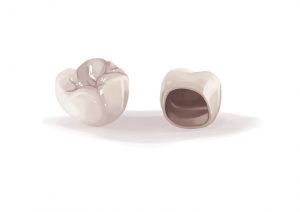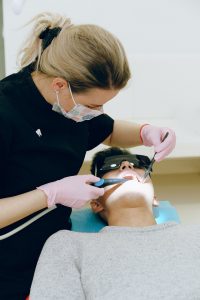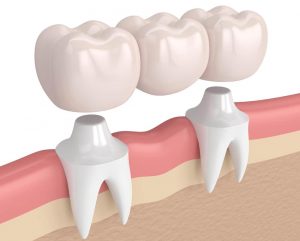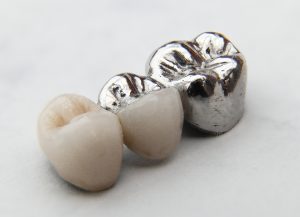 What are Dental Crowns?
What are Dental Crowns?
A crown is that part of the tooth that can be seen in the patient’s mouth. Whenever the natural crown gets damaged due to tooth decay, chips off or fractures, the surface integrity breaks down. Thus, an artificial crown or “cap” is placed on the natural tooth to cover it and prevent further damage. It also restore the normal appearance and function of the teeth.
Dental crowns can be made of different materials like metal (gold, stainless steel etc), ceramic, porcelain or resin material. The material can be toot colored (ceramic, porcelain, resin) or have metallic shades (gold, stainless steel).
Placing a dental crown after a root canal treatment or implant procedure is mandatory. Other than that, normal tooth decay can also call for placement of a crown.
Your dentist will consider a variety of factors to determine which type of crown is best for you. These factors may include:● Where the tooth is located
- What is the function of the tooth
- Health of your gums and position of gum line
- Area of teeth that is shown when smiling
- What is the color or shade of the adjacent teeth
- If there are any habits – like teeth grinding, teeth clenching, tongue thrusting etc.
“A dental crown, if placed properly by the dentist and taken care of by the patient, can easily last up to 10 years, maybe even more”
Why should I get a Dental Crown?
Dental crowns are commonly used to restore:
- Teeth weakened by caries or tooth decay
- Teeth that have chipped off or cracked because of some mechanical force or pressure
- Teeth that have been worn down by repeated teeth grinding (bruxism), forceful brushing habit or chemical abrasives like in soda drinks
- Teeth that require very large fillings and have lost most of their natural tooth structure need to be supported by crowns
- Teeth that have discolored or turned yellow over time can be restored to a more desirable shade using dental crowns or veneers
Dental Crowns are also placed after certain dental procedures like root canal treatment or dental bridge placement because the natural tooth becomes quite weak after these procedures.
Dental Implants
Dental Crowns are used to replace the crown portion of missing teeth after an implant has been placed into the jawbone. This implant acts as an artificial root and takes a few months to heal completely.
Implant Procedure: FA hole is drilled into the jawbone and the implant screw is placed into the tooth socket. This area is closed back up and allowed to heal for a few months. Once the bone fuses with the implant material (osseointegration), the implant abutment is placed. A temporary covering is placed on the abutment and time is again given for the healing process.
Placing Dental Crown: Once complete healing has taken place, a dental crown will be fabricated based on the measurements taken and positioned on top of the abutment. Out of the entire assembly, only the dental crown is visible. Dental crowns can mimic the shape, look, and functionality of natural teeth completely here. The implant assembly is also quite strong and usually resistant to normal tooth decay. They tend to last for almost a lifetime in healthy patients who practice good oral hygiene regularly.
Root Canal Treatment
Root canal treatment, or endodontic treatment, is carried out whenever infection in a tooth has become so severe that it has reached the pulp chamber (the core of the tooth which keeps the tooth alive through its blood and nerve supply).
RCT removes this infected pulp and restores it with a biocompatible material. This procedure can increase the lifespan of the tooth, without the need for extraction, or its removal.
Since the tooth is no longer vital or “alive” (because of absence of pulp), it becomes weak and must be protected with a dental crown. If not, this RCT treated tooth can fracture easily under pressure.
Root Canal Procedure: The dentist will make a small opening in the centre of the natural tooth to remove the infected pulp using special instruments. A biocompatible material will be filled into the core, to fill the pulp space, and a temporary filling will be placed on top.
Placing Dental Crown: Dentists usually place a permanent restoration on the RCT treated tooth a few days or a week after, ensuring the treatment has been successful. Dental crowns are most commonly placed as a permanent restoration If however, enough tooth structure is remaining and the patient wishes to, composite filling can also be placed.
Dental Bridges
A dental bridge consists of three parts- a single crown (or more) in the centre which replaces the missing teeth, and two supporting anchors on either side, which are bonded to adjacent natural teeth for support.
Broadly, five types of bridges can be found at the dental office, which are: Traditional, Cantilever, Maryland, Implant-supported and composite bridges.
Dental Bridge Procedure: Traditional dental bridges are used to fill gaps or missing teeth in the dental arch and need strong adjacent teeth for support. The adjacent teeth that support the bridge are called as abutments and need to be trimmed down by the dentist before bridge placement. If taken care of, dental bridges can last a really long time.
Placing Dental Crown: To offer support to the bridge, adjacent teeth are trimmed down and hence need to be “capped” or “crowned”. These crowns protect the abutment teeth from any damage.
Different Types of Dental Crowns
There are five types of dental crowns available, including:
Porcelain-Fused-to-Metal Crowns
The most popular type of dental crown is the porcelain-fused-to-metal crown because it provides both strength (due to the metal core) and aesthetics (outer porcelain layer). The porcelain fuses to the metal through an oxide bond and is very durable. They are also quite affordable, compared to all-ceramic crowns.
The base metal can be made of different metal alloys like chromium, nickel and cobalt. Gold and titanium alloys can also be used for better quality. PFM crowns last for almost 10-15 years and replicate the natural contours, shade and function of natural teeth.
Metal Crowns

Metal crowns are an affordable option for those who aren’t too concerned about the aesthetics of their teeth. They protect the tooth adequately and are fracture resistant. They can come in various shades depending on the type of metal alloy used (nickel, chromium, titanium, gold. The metal alloys can be classified into 3 types- base metal alloys, semi precious alloys and noble metal alloys. Noble metal alloys showcase the strongest and most corrosion-resistant of all.
Since metals can be molded into very thin sheets, metallic dental crowns require very little removal of the natural tooth structure. Therefore, the procedure is more conservative. Metal crowns are usually placed on the back teeth.
Stainless Steel Crowns (SSCs)
Stainless steel crowns are only used in children, as a temporary crown placement, until the permanent teeth come in. They are usually placed following pulpotomy (removal of pulp in baby teeth, very similar to RCT) or if normal fillings (like amalgam restorations) are destined to fail.
All-Ceramic Crowns
Ceramic crowns are made using tooth colored porcelain material. They mimic the natural color, shade, and look of the human teeth more closely than any other material. They can therefore be slightly more expensive than metal or PFM crowns.
Porcelain or ceramic crowns are used to restore the front teeth for better aesthetics. They have good strength, durability, and do not chip off easily. Cosmetic crowns restore anterior (front) teeth and blend in with your natural tooth color. “Zirconia” is a type of tooth colored crown that is classified under ceramic crowns because of their natural tooth appearance. However, zirconia is actually a metal.
All-Resin Crowns
Although resin material can replicate the natural tooth’s look and structure, it is usually not recommended by dentists because of its low fracture resistance and strength. They are less costly than PFM, all metal or all ceramic crowns.
Resin restorations are usually placed only if there is a decay of the primary (milk teeth) and not on permanent teeth.
Steps in Placement of Dental Crown
A dental crown can be placed on the same day (single visit crowns) or a couple weeks later from the first appointment (multiple visit crowns).
Single visit crowns use CAD/CAM technology to fabricate crowns in-office and the patient goes back home happily with the crown in just a couple hours.
First Visit — Radiograph, Tooth Preparation, and Temporary Crown Installation
On the day of the first appointment, the dentist will take an x-ray or radiograph of the tooth to be “capped” and measure parameters like the thickness of the enamel and dentin, the shape of the pulp chamber and periodontal health of the tooth. After that, the tooth will be cut in a shape that allows for easy placement of the crown. This step is called tooth preparation. Metal crowns require less tooth structure to be cut whereas ceramic crowns require the most tooth structure to be cut.
Lastly, a temporary crown will be placed to protect the prepared tooth until the permanent one is created and brought in from the laboratory. Single visit crowns do not require placement of temporary crowns.
Second Visit — Permanent Crown Placement
After a few weeks, the patient is recalled for the second appointment and the permanent dental crown is set in place. A special bonding cement is applied to the crown to ensure it sticks well to the natural tooth. Once placed, the dentist will check for the correct fit and trim any excess if required. There should not be any pain on biting. If it is an anterior tooth, the dentist will also ensure the crown is blending with the natural tooth color adjacent to it.
Sometimes, crown placement may cause slight discomfort so anesthesia can be given if the patient requests it.
Care for Your Dental Crown
Some things to consider once your crown has been placed:
How to Manage Pain
Over-the-counter pain medication like Paracetamol or ibuprofen can be taken in case there is soreness of the jaw, gums or tooth sensitivity. Usually these effects are noticed after the anesthesia wears off and is quite common. The soreness and discomfort will go away in a few days as the gums adjust to the new crown.
However, if there is severe pain or swelling that doesn’t go away even after two-three weeks, visit your dentist again.
Dietary consideration with Temporary Dental Crowns
Temporary crowns are bonded to the teeth with a temporary adhesive and cannot withstand very heavy forces. So, during the time you have a temporary crown in place, avoid eating very hard or sticky foods like
- Candy
- Gum
- Nuts
- Chips
Also avoid using the side of your mouth where your crown is, to bite on food. This may dislodge or fracture the crown. Chew from the other side of the mouth and avoid flossing the temporary dental crown.
Normal eating habits can be resumed once the dentist places a permanent crown. But adequate time needs to be given for the adhesive to set properly, so always check with your dentist first.
What is the cost of a Dental Crown?
Depending on the material and type of the dental crown chosen, the treatment cost varies.
Below are the approximate rates (without insurance) for the different types of dental crowns available in the market (per tooth)
PFM Crowns — 2500-3000 shekels
All Ceramic Crowns — 3000-4000 shekels
Metal and Gold Crowns — 2500-3000 shekels
Stainless Steel Crowns — 1000 shekels
All-Resin Crowns — 3000-4000 shekels
Frequently Asked Questions(FAQs)
Are dental crowns covered by HSA?
The HSA or Health Savings Amount (HSA) is a means by which patients can pay their dental bills. Regular consultation, x-rays, and teeth cleaning are some preventative treatments included in this payment option. Other minimally invasive procedures like root canals, crowns, bridges, fillings, and even implants can be paid using the HSA.
Does it hurt to get dental crowns?
During crown placement, patients may experience slight discomfort when the crown is seated on to the tooth. Some pressure may be applied to ensure there is a tight fit of the crown. However, patients need not be concerned about pain since local anesthesia can be given to manage the discomfort. After the local anesthesia’s effect wears off, the surrounding gums and jaw may feel sore, which will quickly disappear in a couple days.
How long does a dental crown last?
Usually, crowns last between 10-15 years. If taken care of properly, they can even last up to 30 years. So always practice good oral hygiene. Use interdental aids and floss to keep the area around the crown clean. Stainless steel crowns are temporary crowns which are placed only on milk teeth until the permanent teeth come in.

